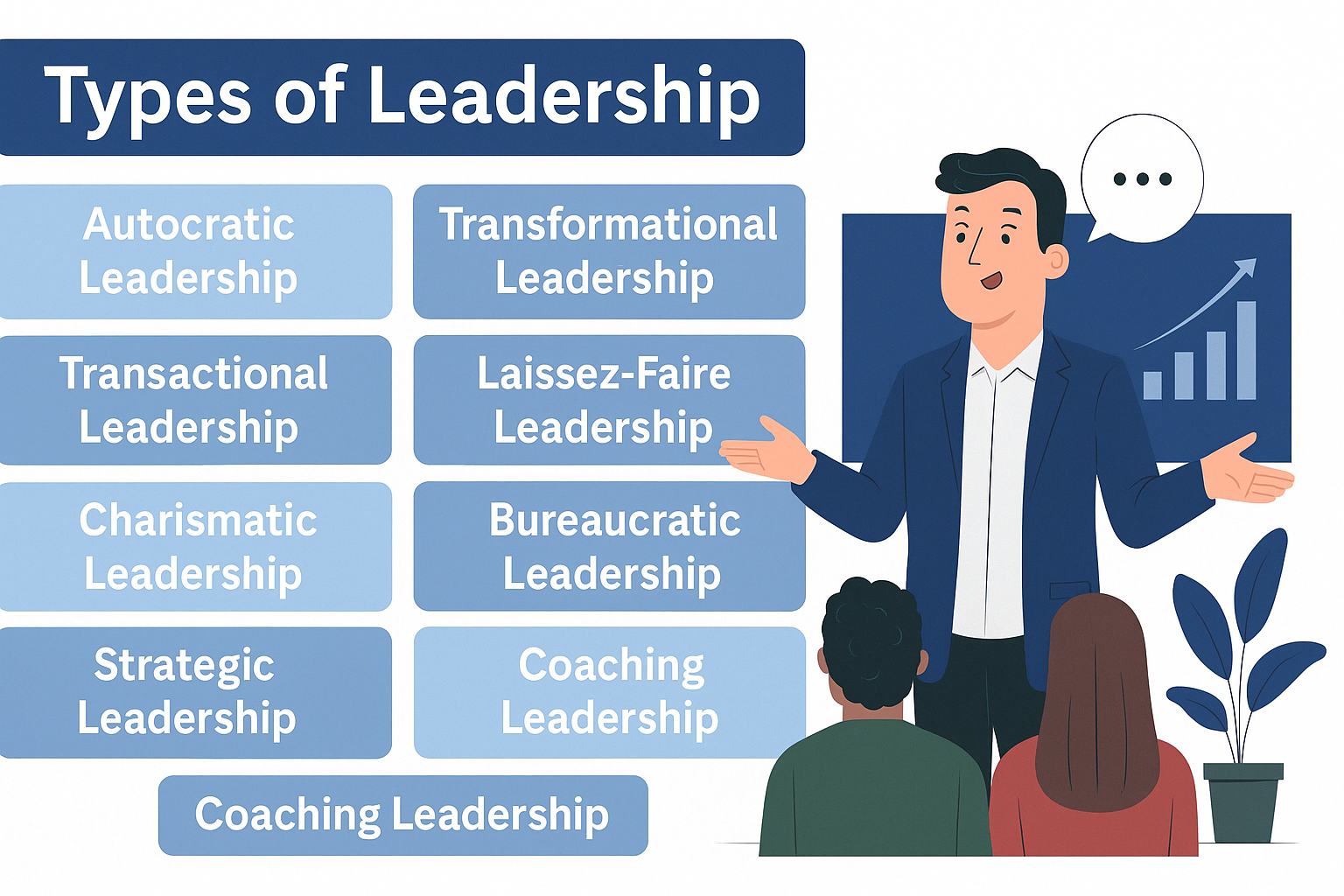The capacity to lead, inspire, and motivate others to accomplish shared objectives is known as leadership. But not every leader takes the same approach. Different types of leadership are needed for various teams, problems, and circumstances. By understanding the many types of leadership, organizations can choose the best candidates for open positions, and individuals can become more successful and adaptable leaders.
The most well-known and often used leadership styles in politics, business, education, and daily life are listed below.
1. Leaders with an autocratic style
The leader in an authoritarian leadership style makes choices without consulting many others. They keep tight control over team direction, policies, and processes.
Ideal for: Circumstances requiring prompt decision-making, such crises or military operations. An example would be a boss who gives out assignments fast and expects staff members to obey commands without inquiry.
2. Leadership in Democracy
This approach, which is sometimes referred to as participatory leadership, includes team members in the decision-making process. The leader appreciates feedback and promotes teamwork.
Ideal for: Innovative companies, collaborative ventures, and creative settings. Example: Before choosing the final product plan, a project manager solicits input from the team.
3. Leadership Through Transformation
Followers of transformational leaders are inspired and motivated to go above and beyond. They emphasize personal growth, transformation, and lofty objectives.
Ideal for: Businesses undergoing expansion, transformation, or performance improvement. An example would be a CEO who pushes a business to invest in training and embrace digital change.
4. Leadership via Transactions
Structure, well-defined objectives, and performance-based incentives or penalties are the main foci of this leadership style. It is less concerned with innovation and more task-oriented.
Ideal for: Routine tasks, short-term objectives, or performance-based settings. An example would be a sales team leader who routinely assesses performance and gives incentives to top salespeople.
5. Leadership with Laissez-Faire
Let them do what is meant by laissez-faire. These leaders provide their team members with little oversight and a great deal of autonomy to operate as they see appropriate.
Ideal for: Groups of seasoned professionals or self-driven people. For instance, the entrepreneur of a computer business who allows programmers to choose their own working hours and schedules.
6. Leadership by Servant
The needs of the group or community come first for servant leaders. They value support, empathy, and active listening more than power or dominance.
Ideal for: Collaborative workplaces, educational institutions, and nonprofit organizations. An example would be a principal who helps staff and teachers improve the learning environment for pupils.
7. Enthusiastic Leadership
Charismatic leaders draw followers with their charisma, personality, and ability to persuade. Because of their vision and drive, others follow them.
Ideal for: Moments of inspiration, crisis, or significant transition. For instance, a political figure who uses speeches and personal tales to motivate a cause.
8. Leadership in Situations
Situational leadership is modifying one’s approach according to the team’s maturity level or environment. In certain situations, a situational leader may be more helpful, and in others, more directive.
Ideal for: Supervisors of varied teams or projects with fluctuating requirements. An example would be a team leader who gives a new hire practical assistance while granting a seasoned employee more autonomy.
9. Leadership in Bureaucracy
Bureaucratic leaders adhere rigorously to the hierarchy, regulations, and policies. They often avoid taking chances and expect others to follow suit.
Ideal for: Work requiring compliance in government, regulations, or administration. An example would be a manager of the finance department who demands written processes and approval requirements.
10. Leadership with Vision
A compelling future vision is possessed by visionary leaders. They encourage people to strive for a common vision by concentrating on long-term objectives.
Ideal for: New businesses, enterprises undergoing transformation, or sectors driven by innovation. An example would be an entrepreneur who leads a group of individuals to develop new transportation models with the goal of transforming how people travel.
The Significance of Different Leadership Styles
By understanding different types of leadership, people can discover their natural style and learn how to adapt it when necessary. Different teams and challenges require different approaches. By choosing the right leadership style or blending several leaders can boost motivation, improve communication, and achieve better results.
In conclusion
There isn’t a single leadership style that fits every situation. The most successful leaders understand the strengths and weaknesses of different types of leadership and know when to apply them. By recognizing these various styles, individuals and organizations can make informed decisions that improve performance, support teams, and build lasting cultures of trust and success.


